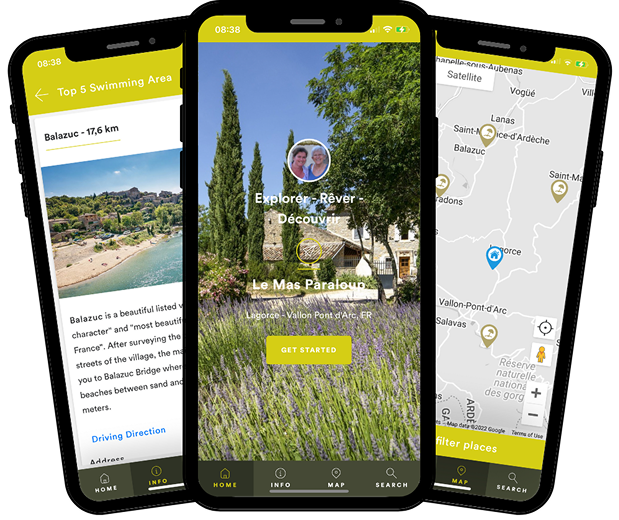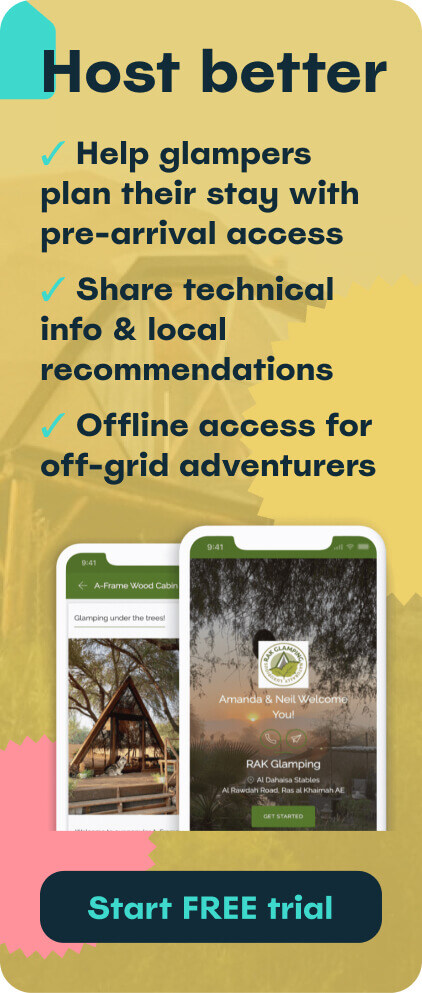Thinking about starting a glamping business and offering nature immersion without sacrificing comfort?
Glamping combines the best of camping and luxury, redefining outdoor adventures and providing your guests with an unforgettable experience.
In this comprehensive guide, we'll take a look at:
Looking to save hours on guest communications, and boost revenue with upsells?
Generate your guidebook in seconds
Simply paste your Airbnb or Booking listing link. No card required.
What is glamping?
Glamping is a fusion of the words "glamorous" and "camping.” It refers to camping in places and situations that offer a touch of luxury and extra amenities. Think of it as “the great outdoors meets boutique hotel vibes”.
Glamping accommodations can range from stylish canvas tents and yurts to chic treehouses and eco-pods.
These setups are designed to provide a cozy and lavish stay while being surrounded by nature's splendor.
Imagine offering guests the experience of sleeping under the stars with the added comfort of a plush bed and waking up to the sound of birds, not the buzz of an alarm clock.
Whether it’s a safari tent in the Southwest or a floating cabin in the Pacific Northwest, glamping destinations blend the allure of the outdoors with the ease of modern living, ensuring an unforgettable adventure that redefines what it means to camp.
History of glamping
While glamping might be a new thing, the concept of luxurious outdoor accommodations goes way back. For instance, during the Ottoman Empire, Sultans would set up extravagant tents for their military campaigns and diplomatic meetings, equipped with lavish furnishings and amenities.
The modern glamping movement began to take shape in the early 2000s as travelers sought unique and comfortable ways to experience nature. This trend was fueled by a growing desire for sustainable tourism and eco-friendly accommodations that don’t compromise on comfort.
By 2016, the word "glamping" had made it into the Oxford English Dictionary.
Today, glamping has evolved into a diverse industry offering a wide range of accommodations, from safari tents and yurts to treehouses and airstream trailers.
The glamping market has seen significant growth over the past decade. As of 2023, the global glamping market was valued at approximately $2.5 billion, and it’s expected to reach USD 7.74 billion by 2033. This growth is mainly due to increasing consumer interest in outdoor experiences combined with luxury, as well as the rise in eco-conscious travel choices.
Glamping vs. camping
The key difference between glamping and camping lies in the level of comfort and amenities you can offer.
While camping typically involves setting up a basic tent and embracing a more rugged lifestyle, glamping elevates the experience by providing well-appointed accommodations with perks like electricity, running water, and even full bathrooms.
Glamping is not about roughing it. You might offer a tent, but this tent could have a real bed, elegant furnishings, and even climate control.
It's a way for your guests to connect with the outdoors without the hassle of pitching a tent or cooking over a fire unless they want to.
Despite its luxurious twist, glamping remains more affordable for guests than staying at a high-end resort. It provides a unique blend of comfort and adventure, allowing guests to unwind in style while still being immersed in natural surroundings.
This blend of comfort and wilderness is something that traditional luxury experiences often miss, making glamping an attractive business opportunity.
Here are the key differences between camping and glamping:
- Required equipment: Camping typically requires bringing your own gear, including a tent, sleeping bag, cooking supplies, and other essentials. Glamping, on the other hand, often provides all necessary equipment, including pre-set tents or cabins, bedding, and cooking facilities.
- Place for sleeping: When camping, you usually sleep in a basic tent or under the stars with minimal protection from the elements. Glamping offers more luxurious accommodations, such as spacious tents, yurts, or cabins, often equipped with real beds, furniture, and climate control.
- Water supplies: Campers often need to bring their own water or have access to a nearby natural water source, and may need to purify it. Glamping sites typically provide running water, including potable water and sometimes even bottled water for convenience.
- Cooking and food: Camping often involves cooking over a campfire or portable stove, with meals typically being simple and easy to prepare. Glamping sites often feature fully equipped kitchens or provide meal services, allowing for a wider variety of culinary options and more elaborate meals.
- Restroom and shower: Traditional camping usually requires using communal restrooms, portable toilets, or digging a latrine, with limited access to showers. Glamping offers private restrooms and showers, often with hot water and modern amenities.
- Climate Control: When camping, you rely on layers of clothing and sleeping bags to stay warm, and there’s no way to cool down other than natural ventilation. Glamping accommodations often include heating and air conditioning or fans, allowing for better control of the indoor climate.
- Internet access: Internet access is rare when camping, where the experience is more about disconnecting from technology. Glamping sites cater to those who want to stay connected while enjoying the outdoors and often provide Wi-Fi.
- Overall comfort: Camping is a rugged experience that requires you to make do with basic comforts and close contact with nature. Glamping combines the adventure of camping with the luxury of hotel-like amenities, offering a more comfortable and accessible way to enjoy the outdoors.
What are the benefits of glamping?
a) Convenience
Glamping offers the convenience of having everything set up for you upon arrival, eliminating the need for extensive packing and setup. With accommodations, amenities, and sometimes even meals provided, you can spend more time relaxing and exploring.
b) Available in all seasons
Glamping sites are often designed to be used year-round, with options for heating and cooling to ensure comfort in any season. This allows you to enjoy nature regardless of weather conditions, making it a versatile vacation choice.
c) Perfect for couples & families
Glamping provides a comfortable and enjoyable experience that appeals to both couples and families. With larger spaces and added amenities, it’s easier to accommodate groups of all sizes, making it an ideal option for a romantic getaway or a family vacation.
d) Minimum equipment is required
Unlike traditional camping, glamping requires you to bring minimal equipment since most essentials are already provided. This makes it accessible for those who may not own camping gear or prefer not to deal with the hassle of transporting and setting up equipment.
e) Luxurious accommodations
Glamping accommodations are designed to offer the comforts of home, such as real beds, private bathrooms, and sometimes even kitchens or hot tubs. This luxury makes the experience more appealing to those who might be hesitant to camp in rugged conditions.
f) Surrounding nature
Glamping sites are typically located in beautiful natural settings, allowing guests to immerse themselves in nature while still enjoying modern comforts. This provides the best of both worlds: the serenity of the outdoors with the conveniences of a hotel.
g) Wide price range
Glamping options range from budget-friendly to ultra-luxurious, making it accessible to a variety of budgets. Whether you’re looking for a simple, cozy tent or a high-end cabin with all the bells and whistles, there’s a glamping option to fit your financial plan.
Types of glamping accommodations
Luxury tents

One of the most iconic forms of glamping is the luxury tent.
Picture your guests unwinding in a tent with comfortable beds, chic furnishings, and even electricity.
Many luxury tents also feature private decks, perfect for sipping your morning coffee while taking in the surrounding scenery.
Yurts

Traditionally used by nomadic cultures in Central Asia, these circular tents often feature hardwood floors, cozy beds, and heating, making them suitable for year-round adventures.
Offering yurts allows your guests to experience a piece of nomadic heritage while enjoying the comforts of modern life.
Camping cabins

If your guests crave more traditional comforts, luxury cabins are an excellent choice.
These often come equipped with full kitchens, bathrooms, and even hot tubs.
Cabins can range from rustic log structures to modern architectural marvels, providing a home-away-from-home feeling.
They’re perfect for families or groups, offering plenty of space and amenities to make their stay comfortable.
Airstreams & trailers

With their iconic silver exteriors and retro charm, Airstream or luxury RVs are often equipped with all the amenities of a small apartment, including kitchens, bathrooms, and cozy sleeping quarters.
RV glamping allows your guests to explore multiple destinations with ease while enjoying the comforts of a well-appointed living space.
Domes

Glamping domes are a newer addition to the world of luxury camping.
They can be outfitted with plush furniture, heating, and even skylights for stargazing.
The panoramic windows often found in glamping domes provide breathtaking views, making them an excellent choice for nature lovers who want to feel connected to their surroundings while enjoying high-end comfort.
Lodges

Lodges offer a luxurious and spacious glamping experience, often located in scenic areas such as mountains, forests, or lakesides.
These structures can be similar to traditional homes, complete with multiple bedrooms, large kitchens, and living areas. Guests can enjoy all the comforts of home while being immersed in nature, making lodges ideal for larger groups or extended stays.
Treehouses

For a whimsical and adventurous glamping experience, treehouses are hard to beat. Elevated among the treetops, modern treehouses can be incredibly luxurious, featuring everything from hot tubs to full kitchens.
Imagine offering your guests the experience of drifting off to sleep with the gentle sway of the trees and waking up to the sound of birdsong right outside their window.
Villas

Villas bring the luxury and privacy of a high-end hotel to the outdoors.
These accommodations typically include multiple bedrooms, private pools, and expansive living spaces.
Offering villas can provide your guests with a secluded and lavish retreat, perfect for special occasions or exclusive getaways.
Safari tents

Inspired by the classic African safari experience, safari tents are usually larger than standard camping tents and come equipped with luxurious amenities like king-sized beds, en-suite bathrooms, and even kitchenettes.
Safari tents often feature a mix of canvas and wood, creating a rustic yet refined aesthetic.
Offering safari tents can give your guests a unique and exotic glamping experience.
Houseboats

For a truly unique glamping experience, consider offering stays on houseboats.
These provide all the luxuries of a cabin with the added benefit of being on the water.
Houseboats often come equipped with full kitchens, living areas, and spacious decks.
Whether docked in a serene lake or gently floating down a river, houseboat glamping provides a peaceful and novel way for your guests to connect with nature.
Best places for glamping
National parks

National parks are a natural choice for setting up your glamping business, and many parks now feature glamping options such as safari tents, yurts, and luxury cabins.
Imagine offering your guests the experience of waking up in a plush bed, stepping outside their tent, and being greeted by the awe-inspiring vistas of the Grand Tetons or the serene beauty of Glacier National Park.
Places to try:
- Majestic Utah Yurts, 20 minutes from Zion National Park (Utah)
- Mahal Yurt near Grand Canyon National Park (Arizona)
- Under Canvas Zion near Zion National Park (Utah)
- Alpenglow Luxury Camping at Wrangell–St. Elias and Denali National Parks (Alaska)
- Dunton River Camp at Mesa Verde National Park (Colorado)
Coastal retreats

For those who love the sound of waves and the smell of salt air, coastal glamping is a dream come true.
Coastal retreats along the Pacific Coast, such as Big Sur in California or the Oregon Coast, provide dramatic ocean views and unique glamping accommodations like Airstreams and beachfront tents.
In the East, spots like the Outer Banks in North Carolina or Cape Cod in Massachusetts offer charming glamping sites where guests can enjoy the beach by day and luxurious comfort by night.
Places to try:
- Timberline Glamping on the Florida Coast
- Firelight Camps in New York’s Finger Lakes region
- Sandy Pines Campground in Maine
- Mendocino Grove in California
- Camp Olowalu in Maui, Hawaii
Mountain escapes

The mountains provide a perfect backdrop for setting up your glamping business.
Locations like the Rocky Mountains, the Blue Ridge Mountains, and even the Swiss Alps (if you’re considering international options) offer ideal settings for glamping accommodations.
Imagine offering your guests a cozy cabin in Colorado, with a roaring fire and panoramic views of snow-capped peaks. Or perhaps a yurt in the Smoky Mountains, where they can hike during the day and relax in a hot tub at night.
Places to try:
- Hub North near Wildcat Mountain (New Hampshire)
- The Resort at Paws Up (Montana)
- Treebones Resort in Los Padres National Forest (California)
- Dunton Hot Springs in the San Juan Mountains (Colorado)
- Glacier Under Canvas near Glacier National Park (Montana)
Countryside retreats

Regions like the Napa Valley in California, the Hudson Valley in New York, and the Texas Hill Country are renowned for their picturesque landscapes and charming glamping options.
Consider setting up luxury tents on a vineyard in Napa Valley or glamping pods in the rolling hills of the Hudson Valley.
These locations offer a tranquil escape from the hustle and bustle of city life, allowing your guests to unwind in nature's embrace.
Places to try:
- The Nest in Woodstock (New York)
- Wildhaven Yosemite in Mariposa (California)
- The Ranch at Rock Creek (Montana)
- Firelight Camps in the Finger Lakes region (New York)
- AutoCamp Russian River in the redwoods of Sonoma County (California)
Desert oases

For a truly unique glamping experience, consider setting up your business in a desert oasis.
The stark beauty of the desert provides a dramatic backdrop for luxury accommodations. Locations like Joshua Tree in California and the Sonoran Desert in Arizona offer ideal settings for glamping sites where guests can experience the desert’s magic.
Picture them spending nights in a luxurious tent under a blanket of stars and days exploring the dunes and canyons.
Places to try:
- Utah desert at Ulum Moab
- Yurt at the popular Desolation Hotel Hope Valley in California.
- Shash Dine' EcoRetreat on Navajo land near Page (Arizona)
- El Cosmico in the Chihuahuan Desert (Texas)
- The Desert Camp at Amangiri (Utah)
Unique spots

Some glamping destinations stand out for their uniqueness and creativity.
Consider offering stays in a treehouse in the Redwoods of California or a luxury tent built into the cliffs of Utah.
There are also unique glamping opportunities with overwater bungalows in the Florida Keys or houseboats on the tranquil lakes of Minnesota.
These distinctive spots offer a one-of-a-kind experience that will make your glamping business truly unforgettable for your guests.
Places to try:
- West Beach Resort in Orcas Island (Washington state)
- Dunton River Camp, set inside a 1800s cattle ranch (Colorado)
- The Vintages Trailer Resort (Oregon) in Willamette Valley wine country (Oregon)
- The Dome in the Desert in Joshua Tree (California)
- Nomad Ridge at The Wilds (Ohio)
How to set up a glamping site?
Want to start a glamping business? Creating an amazing glamping adventure for people is not only doable but also immensely rewarding.
Whether your guests are seasoned campers or new to outdoor adventures, glamping adds a layer of comfort and luxury that will transform their time in nature.
1. Perform a thorough market research
Start by identifying the ideal location for your glamping site, considering factors such as accessibility, natural beauty, and proximity to attractions.
Check out the competition in the area to understand their pricing strategies, services offered, and customer reviews. Analyzing market trends will also help you understand what glampers are looking for so you can tailor your offerings to meet their expectations and stand out in a competitive market.
2. Analyze your target audience
Determine who your potential guests are—families, couples, solo travelers, or groups—and what they value in a glamping experience. This analysis will help you design your site and services to cater specifically to their preferences and needs. Consider conducting surveys or focus groups to gather insights directly from your potential customers. Tailoring your marketing efforts to resonate with your target audience will also be more effective, helping you attract and retain guests.
3. Prepare a functional business plan
Outline your business goals, strategies, and financial projections in detail. This plan should cover all aspects of your operation, from marketing and customer service to daily operations and long-term growth strategies. A comprehensive business plan not only helps you stay organized and focused but also makes it easier to secure financing from investors or lenders. Be sure to include contingency plans to address potential challenges and changes in the market.
4. Consider costs and ROI
Start by calculating the initial setup costs, including land acquisition, construction or renovation of glamping units, furnishings, and amenities. Don’t forget to factor in ongoing operational expenses such as maintenance, utilities, staffing, and marketing.
Next, estimate potential revenue based on your pricing strategy and occupancy rates to determine your expected ROI.The better you understand these numbers, the easier it will be to make informed decisions so that your business remains profitable.
5. Make the glamping place luxurious & comfortable
To create a memorable experience for your guests, focus on making your glamping site luxurious and comfortable. This involves selecting the right types of accommodations, creating a welcoming atmosphere, and offering a range of amenities that go beyond the basics.
Start with shelter
The first step to creating a successful glamping place is building (or upgrading) the shelter. Instead of basic tents, consider investing in spacious canvas tents, yurts, or bell tents.
These options provide more room and better insulation, enhancing the comfort of your guests.
Today, you can find glamping tents with features like multiple rooms, tall ceilings, and built-in flooring.
If you're sticking with a regular tent, accessorize it to enhance comfort.
Use thick, cushioned sleeping pads or inflatable beds. Add soft blankets, cozy sleeping bags, and even a duvet for a touch of home.
The goal is to create a space that feels more like a bedroom than a campsite.
Create a cozy ambiance
Battery-powered LED string lights can provide a warm, inviting glow. Lay down a decorative rug to give the tent a homey feel, and scatter some plush throw pillows around.
Consider bringing folding chairs or even a small foldable table to add convenience and style.
For those who enjoy a themed experience, you can decorate your glamping sites to match.
Whether it’s boho chic with macramé and lanterns or rustic charm with wooden accents and vintage decor, your tent can reflect your personal style.
Provide a culinary experience for your glamping guests
Your guests will probably be looking at leaving behind the basic trail mix and instant noodles, so offer them a portable stove or grill for more elaborate meals.
You might even pack a cooler with beverages, some artisanal cheeses, and a selection of fruits as a surprise breakfast.
Or consider offering an option to order campfire-friendly desserts like s’mores with gourmet chocolate or pre-made dough for campfire pies.
Add comforts of home: Little luxuries matter
Provide a portable power bank to keep your guests' devices charged or a small, battery-operated fan for warm nights.
For cooler evenings, consider offering an outdoor-safe heater.
Include a portable shower along with biodegradable soaps and shampoos to keep the experience eco-friendly.
These small touches will add a layer of comfort and convenience, making your glamping site feel like a home away from home for your guests.
Provide unforgettable glamping experiences
Glamping is more than just about where your guests sleep – it’s about the entire experience.
Consider providing a portable projector and screen for an outdoor movie night. Offer board games or a deck of cards for evening entertainment.
If your site is near water, consider renting out kayaks or paddleboards.
For a truly unique experience, consider offering additional amenities like hot tubs, guided tours, or even spa services.
If you can't offer these services yourself, set up your glamping business near places where guests can easily access them and then provide them with a guide to help them find those places.
Pro Tip: Consider hiring glamping influencers to promote your glamping site.
6. Use reservation management system
Implementing a reservation management system is crucial for streamlining bookings and managing availability. A good system will help you keep track of reservations, avoid double bookings, and provide a smooth booking experience for your guests. It can also automate communication with guests, sending them confirmations, reminders, and any other necessary information. This not only enhances customer satisfaction but also frees up your time to focus on other aspects of running your glamping site.
7. Promote your glamping site
Start by building a direct booking website where potential guests can learn about your offerings and make reservations. Use social media platforms to showcase your glamping experience through photos, videos, and guest testimonials.
Listing your site on popular booking websites such as Airbnb, Booking.com, Google My Business, Glamping Hub, Cool Camping, Vrbo, and Hostaway can also increase your visibility and reach a wider audience. Effective promotion will ensure that your glamping site attracts a steady stream of guests.
8. Create online brochures for your guests
Creating digital guidebooks can greatly enhance the guest experience by providing them with all the information they need in one place. Tools like Touch Stay can help you create detailed guidebooks that include local attractions, dining options, site amenities, and safety information.
Online brochures are easily accessible and can be updated regularly to reflect any changes or new offerings so guests know exactly what to expect and how to make the most of their glamping adventure.
Pro Tip: Learn here how to create a digital guidebook for your glampsite.
Tips for a perfect glamping experience
Pick the right destination & time
Choose a destination that suits your preferences, whether it's a forest, beach, or mountains. Research the best time of year to visit, considering weather conditions and peak seasons to ensure a comfortable and enjoyable experience.
Set your budget
Determine your budget before planning your trip to find options that fit your financial plan. Consider the cost of accommodations, travel, meals, and any additional activities or amenities you might want to enjoy.
Pack smart, not hard
Bring essential items to enhance your comfort and convenience without overpacking. Here’s a simple list:
- Comfortable clothing and shoes
- Toiletries and personal hygiene items
- Flashlight or headlamp
- Reusable water bottle
- Portable phone charger
- Insect repellent
- Sunscreen
Enjoy local cuisine
Take advantage of local food options to enhance your experience. Whether it's a nearby restaurant or a market, sampling regional dishes can add a delicious and authentic touch to your glamping adventure.
Stay eco-friendly & leave no trace
Practice sustainable habits by minimizing waste and respecting nature. Use reusable items, dispose of trash properly, and leave your glamping site as pristine as you found it.
Unplug & relax
Take the opportunity to disconnect from digital distractions and immerse yourself in nature. Enjoy the tranquility, engage in outdoor activities, or simply relax and rejuvenate in your comfortable glamping setup.
Frequently asked questions
How does a glamping business make money?
A glamping business makes money by providing unique, luxurious outdoor accommodations at a higher price point than traditional camping. Revenue comes from nightly rental fees, and additional income can be generated through offering extra services like guided tours, meals, or special activities.
How much can you charge customers for glamping?
Prices for glamping can vary widely depending on the location, amenities, and level of luxury provided. Generally, you can charge anywhere from $100 to $500 per night, with some high-end experiences costing even more.
What is the best time of year to go glamping?
The best time to go glamping depends on the location and climate. Generally, spring and fall are popular due to milder weather, but summer is also a favorite for destinations with cooler climates. Always check the seasonal conditions of your chosen location before booking.
Is glamping expensive?
Glamping can be more expensive than traditional camping due to the added comforts and amenities. However, it offers a unique experience that combines the beauty of nature with the comforts of home, making it worth the cost for many travelers.
What is a glamping tent?
A glam tent is a stylish and comfortable tent used in glamping. These tents often come with real beds, furniture, lighting, and sometimes even en-suite bathrooms, providing a luxurious camping experience.
What is the difference between a camping tent and a glamping tent?
A camping tent is typically basic and functional, designed for portability and ease of setup. In contrast, a glamping tent is larger and more elaborately furnished, focusing on comfort and luxury, often including amenities like real beds, electricity, and even bathrooms.
Do glamping tents have toilets?
Many glamping tents come equipped with toilets, either as part of the tent itself or in nearby facilities. This convenience adds to the luxurious experience by providing the comforts of home while staying in nature.
Is glamping eco-friendly?
Glamping can be eco-friendly, especially if the business follows sustainable practices such as using renewable energy, offering locally sourced food, and implementing waste reduction measures. The environmental impact is generally lower than traditional hotels and resorts.
Where to book a glamping trip?
You can book a glamping trip through various online platforms specializing in unique accommodations, such as Glamping Hub, Airbnb, and Booking.com. Many glamping sites also offer direct bookings through their own websites.
What to pack for the glamping trip?
Pack comfortable clothing suitable for outdoor activities, toiletries, and any personal items you might need. While many glamping sites provide basic amenities, bringing items like a flashlight, insect repellent, and a reusable water bottle can enhance your experience.

Diana Bocco
Diana Bocco is an experienced writer with a passion for creating engaging content for the hospitality technology and travel sectors. Aside from a portfolio featuring work for industry giants like Booking.com and TripAdvisor, Diana also has extensive experience in creating business and e-commerce content. An avid traveler herself, Diana combines her on-the-road insights with professional expertise to help vacation rental owners enhance guest experiences and grow their businesses.
Be the first to know!
Join our newsletter for early access to:
- ✅ Free guides
- ✅ Pro tips & tricks
- ✅ Time saving tutorials
- ✅ Latest blog posts
- ✅ Checklists & templates


.png?width=50)












